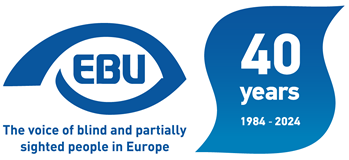The Directive establishing a European Disability Card and a European Parking Card for persons with disabilities was adopted on 14 October, meaning that these cards will become a reality for visually impaired travellers by the end of 2028. See our press release. We will now be looking carefully at implementation in the EU Member States, but also pressing the Commission to address through other legislation, as part of the rest of the current Disability Rights Strategy period, the gap in the text, i.e. the recognition of the disability status for people who move their residence to another EU country.
Our action continues, together with EDF, to raise support within the European Parliament for the re-establishment of the Disability Intergroup. So far EDF has registered 51 expressions of interest to participate in such intergroup, and a dozen more to see it re-established, without asking to be a part of it eventually. More expressions of support are needed to build a strong case.
We attended the EU Disability Platform plenary meeting of 3 October. It was good to hear the future Polish Presidency of the EU announce work to improve accessibility in air transport – although essentially to raise awareness. Like the current Hungarian presidency, they however remained very vague on making progress on the Equal Treatment Directive.
The Commission presented the next Multiannual Financial Framework, as regards ESF+. An update was also given on the flagship initiatives of the current Disability Rights Strategy. Regarding the European Disability Card, the establishment of an expert group was announced, probably within the EU Disability Platform, to help define the technicalities and security features for physical and digital cards.
The European Commission was asked to say what will happen in the second half of the Disability Rights Strategy period (up till 2020), with no other initiative on the table at this point. Their answer suggests that continuity and ambitions of the efforts will depend on the new Commissioner, and that this will in any case be a key element of the next consultations within the EU Disability Platform.
The EU Disability Platform plenary also addressed data at EU level on disability. Eurostat once again showed an effective commitment to progressively improve the existing datasets, with a gradual disaggregation by type of disability. We pointed out that the disaggregation needed to be by area of life, along the lines of what already exists with the Disability Employment Gap, where functional limitations are distinguished.
On 26-27 October, the new EBU Advocacy Committee – formerly Commission for Liaising with the EU, with an enlarged geographical scope – held its first annual in-person meeting in Warsaw. In this meeting, we took in developments in the past year, exchanged on the new EU institutional scene after the European elections and looked ahead to define priority areas of work. Two issues emerged as deserving particular attention: ensuring that silent cars are safe for visually impaired pedestrians, i.e., that the current AVAS requirements are if anything strengthened, not reduced under the pretext of noise reduction concerns; and addressing the gaps of the European Accessibility Act, especially as regards household appliances, where the increased use of touchpad-based operating systems is problematic.
The meeting in Warsaw also provided the opportunity for two interesting moments of exchange:
- with representatives of the Polish Government in the perspective of Poland’s Presidency of the EU Council in the first half of 2025; and
- with a representative of the OSCE’s Office for Democratic Institutions and Human Rights (ODIHR), to explore possible cooperation, in particular in political participation and making elections accessible for visually impaired citizens throughout Europe.
Other noteworthy meetings:
- The EDF European Accessibility Act Peer Support Meeting (9 October). There we engaged with the European Commission representative about the next steps for payments terminals – we were encouraged to feed into the related European standardisation process – as well as about the scope of the EAA as regards ‘back-list’ e-books – with a reassuring stand that they are covered if still on sale after 28 June 2025.
- The AccessibleEU platform’s workshop on the challenges of artificial intelligence (10 October). Digital Europe, very active in this area, presented their (still draft) study on AI to support accessibility. It came from the discussions that there is a risk of AI, as a magnified mirror of society, exaggerating patterns of disparity, by working only on what is good for the majority.” The workshop was part of a consultation process to finalise the study at the end of November.
- A bilateral meeting (21 October), at their request, with representatives of the European Commission’s Joint Research Centre and DG Environment, to consult us on making harmonised waste sorting labelling accessible for visually impaired people in a revised Packaging and Packaging Waste Regulation, both on products and on waste bins.
- Our intervention as programmed speaker at the Irish National Disability Authority annual conference, to give our perspective and present our action (particularly as regards the Marrakesh Treaty) in relation to Article 30 of the UNCRPD (culture, sport and leisure).
- The AccessibleEU European event (30 October) on Accessibility and Higher Education.
We contributed comments to EDF for their draft alternative report to the UN CRPD review of the EU.
We circulated and raised awareness about a Commission DG SANTE survey on improving cancer screening, diagnosis and treatment for persons with disabilities.
At the moment of writing, we are still waiting for a final confirmation from the European Parliament of the date (4 December) and precise venue for the EBU event to liaise with the new MEPs, before being able to send out the invitations.

